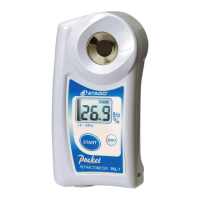(1) Prepare distilled
or
tap
water.
(2) Clean the prism surface
(Fig. 2-1).
(3)
Place
approximately
0.3
ml
of water onto the prism
surface
(Fig.
2-2,
Fig.
2-3).
(4) Press the START
key.
"---"
will
appear,
and
then
the
measured
Brix
value
(%)
as
well
as
the
temperature
of
the
sample
stage
at
the
time
the
measurement
was
taken
will
be
displayed.
(5) If the
display
indicates
"0.0%",
zero
setting
does
not
need
to
be
performed. Wipe the water
off of the prism surface
with a lint free tissue. The
PAL-1
is
ready to
use.
(6)
If
the
indicated
value
is
not
"0.0" , press the
ZERO
key
while
the
water
is
covering
the
prism
(Fig.
2-4).
(7)
After
blinking
2
times,
"000"
will be displayed
on the LCD screen (Fig
2-5). If the display reads
"AAA", add more water
onto
the
prism surface
and press the ZERO key
again.
(8)
When
"000"
is
displayed,
zero
setting
has
been
successfully completed.
Dry the prism surface by
wiping with a tissue. The
PAL-1
is
ready to use.
water
about
O.3ml
Fi
9
'2(tfJ)4
.
ml
"
(
Fig.
2-5
:iiiZiiI
C'D.'1
"C
nnn
LfUU
3.
Measuring
Method
[CAUTION]
• Do not use any metal tools when applying sample
to the prism. Metal can damage the prism surface.
• The temperature of the sample should be the same
as the ambient temperature. If the temperature
is
different, allow the sample temperature to adjust to
the ambient temperature before pressing the
START key to take a measurement.
• The instrument should not come
in
contact with
any sample over 30·e. Warping of the outer casing
may occur, which will diminish the water resistant
feature of the instrument.
• When measuring a hot, viscous sample, be careful
not to spill it outside the metal sample stage. Use
a small spoon to apply only enough sample to
measure on the prism.
•
Avoid
using
water over 30·e
to
clean
a
sample
that
has
dried
and
hardened
on
the
prism
surface.
The
proper
procedure
to
clean
an
encrusted
prism
surface
is
to
use
absorbent
gauze
dipped
in
hot
water,
then
carefully
wipe
the
sample
off.
Avoid
wetting
the
outer
casing
of
the
instrument with the hot water. The
excessive heat can warp the outer casing, which
will diminish the water resistant feature of the
instrument.
• If the ELI" function indicates the Innn] warning
message
on
the LCD screen while measuring a
sample, shade the sample stage with your hand
and press the START key again.
(1) Clean the prism surface.
(2) Place approximately 0.3
ml
of
sample
onto
the
prism surface (Fig. 3-1,
Fig. 3-2).
(3) Press
the
START
key
(Fig.
3-3).
(4) "---"
will
appear,
and
then
the
measured
Brix
value
(%)
as
well
as
the
temperature
of
the
sample
stage
at
the
time
the
measurement
was
taken
will
be
displayed
(Fig.
3-4).
sample
about
O.3ml
www.GlobalTestSupply.com
Find Quality Products Online at: sales@GlobalTestSupply.com

